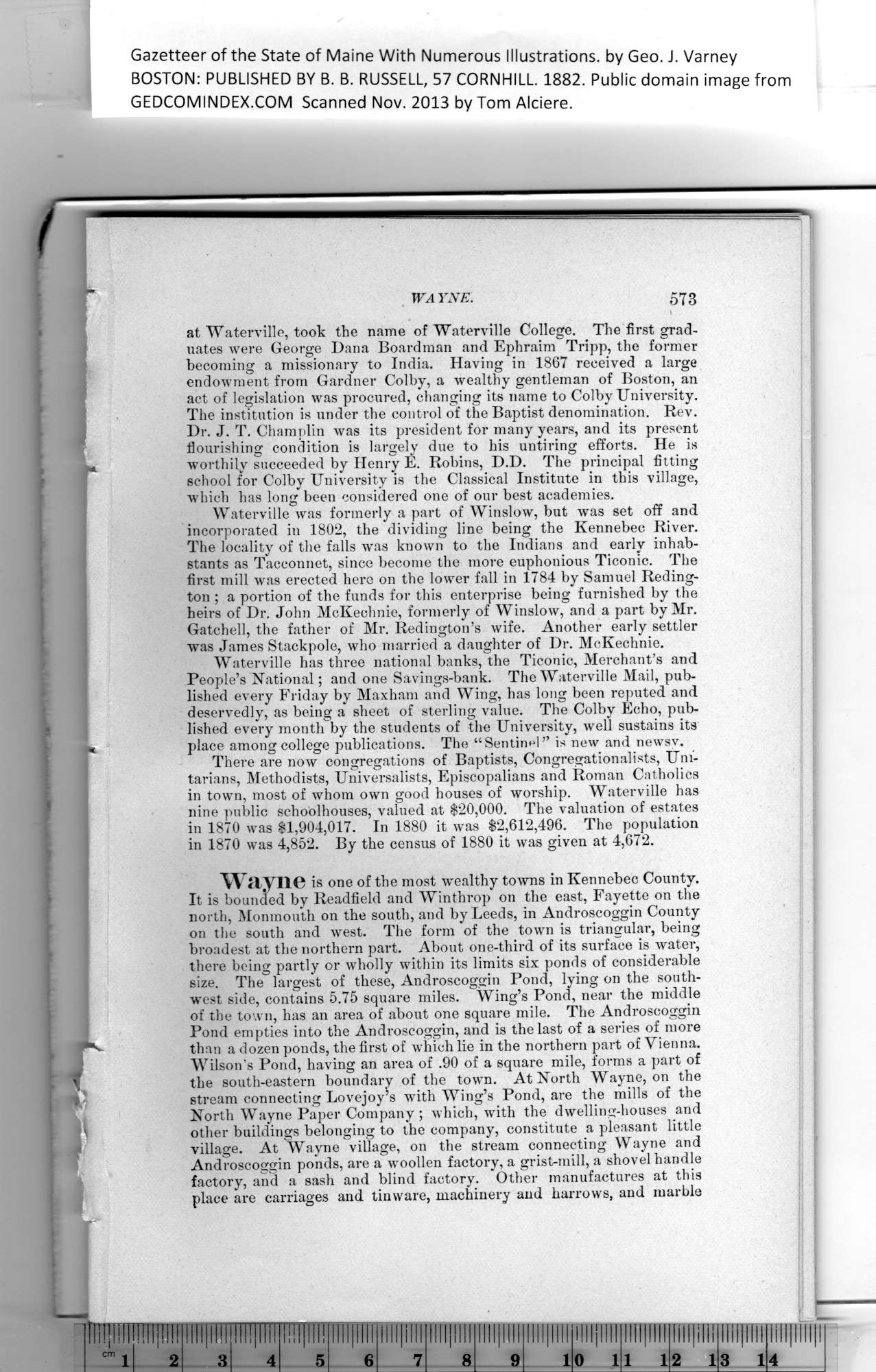|
Gazetteer of the State of Maine With Numerous Illustrations, by Geo. J. Varney
BOSTON: PUBLISHED BY B. B. RUSSELL, 57 CORNHILL. 1882. Public domain image from
at Waterville, took the name of Waterville College. The first grad-
uates were George Dana Boardman and Ephraim Tripp, the former
becoming a missionary to India. Having in 1867 received a large
endowment from Gardner Colby, a wealthy gentleman of Boston, an
act of legislation was procured, changing its name to Colby University.
The institution is under the control of the Baptist denomination. Rev.
Dr. J. T. Champlin was its president for many years, and its present
flourishing condition is largely due to his untiring efforts. He is
worthily succeeded by Henry E. Robins, D.D. The principal fitting
school for Colby University is the Classical Institute in this village,
which has long been considered one of our best academies.
Waterville was formerly a part of Winslow, but was set off and
incorporated in 1802, the dividing line being tbe Kennebec River.
The locality of the falls was known to the Indians and early inhab-
stants as Tacconnet, since become the more euphonious Ticonic. The
first mill was erected hero on the lower fall in 1784 by Samuel Reding-
ton ; a portion of the funds for this enterprise being furnished by the
heirs of Dr. John McKechnie, formerly of Winslow, and a part by Mr.
Gatchell, the father of Mr. Redington’s wife. Another early settler
was James Stackpole, who married a daughter of Dr. McKechnie.
Waterville has three national banks, the Ticonic, Merchant’s and
People’s National; and one Savings-bank. The Waterville Mail, pub-
lished every Friday by Maxham and Wing, has long been reputed and
deservedly, as being a sheet of sterling value. The Colby Echo, pub-
lished every month by the students of the University, well sustains its
place among college publications. The “Sentinel” is new and newsv.
There are now congregations of Baptists, Congregationalists, Uni-
tarians, Methodists, Universalists, Episcopalians and Roman Catholics
in town, most of whom own good houses of worship. Waterville has
nine public schoolhouses, valued at $20,000. The valuation of estates
in 1870 was $1,904,017. In 1880 it was $2,612,496. The population
in 1870 was 4,852. By the census of 1880 it was given at 4,672.
Wayne is one of the most wrealthy towns in Kennebec County.
It is bounded by Readfield and Winthrop on the east, Fayette on the
north, Monmouth on the south, and by Leeds, in Androscoggin County
on the south and west. The form of the town is triangular, being
broadest at the northern part. About one-third of its surface is water,
there being partly or wholly within its limits six ponds of considerable
size. The largest of these, Androscoggin Pond, lying on the south-
w'est side, contains 5.75 square miles. Wing’s Pond, near the middle
of the town, has an area of about one square mile. The Androscoggin
Pond empties into the Androscoggin, and is the last of a series of more
than a dozen ponds, the first of which lie in the northern part of Vienna.
Wilson’s Pond, having an area of .90 of a square mile, forms a part of
tbe south-eastern boundary of tbe town. At North Wayne, on tbe
stream connecting Lovejoy’s with Wing’s Pond, are the mills of the
North Wayne Paper Company ; which, with the dwellingdiouses and
other buildings belonging to the company, constitute a pleasant little
village. At Wayne village, on the stream connecting Wayne and
Androscoggin ponds, are a woollen factory, a grist-mill, a shovel handle
factory, and a sash and blind factory. Other manufactures at this
place are carriages and tinware, machinery and harrows, and marble
PREVIOUS PAGE ... NEXT PAGE
This page was written in HTML using a program written in Python 3.2
|
